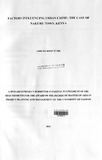| dc.description.abstract | Cities in Kenya are transit, and destination country for men, women, and children trafficked for forced labor and sexual exploitation. Children are trafficked within the country for domestic servitude, street vending, agricultural labor, and sexual exploitation; men, women, and girls are trafficked to the Middle East, other African nations, Western Europe, and North America for domestic servitude, enslavement in massage parlors and brothels, and manual labor. In China, Chinese women trafficked for sexual exploitation reportedly transit Nairobi and Bangladeshis may transit Kenya for forced labor in other countries. In Nakuru, the number of reported cases of crime and violence has continued to escalate.
The aim of this research was therefore, to identify the factors that influence urban crime in Nakuru town. The variables under study included unemployment, informal settlements, illegal weapons and nature of families, which are the major contributing factors of crime. A total of 70 samples composed of 30 respondents drawn from Community Service Orders, 38 probationers and 2 law enforcing agents in Nakuru town namely the CO crime and DPO. For the victims, the study targeted 100 respondents, making a total of 170 samples required for the study. Questionnaires were developed for victims and offenders and interview schedules used for the law enforcing agents.
The Questionnaire was piloted in Naivasha town to similar respondents to improve its validity. The Statistical Package for Social Sciences (SPSS) was used in data entry. The array of data as then was coded and analyzed using descriptive statistics mainly the mean and inferential statistics; correlation of variables to establish the association between the attributes of the variable under study. Frequency distributions were used to present the findings of the study. The results from this study indicated that unemployment was the major factor cited by all the 3 set of respondents followed by illegal weapons, existence of informal settlements and finally nature of families. The general feeling by majority of the respondents is that government needs to provide employment opportunities to the youth as most offenders were aged between 20-35 years. It is expected that the result of this study will add to the existing body of knowledge in the area of crime specifically urban crime.
Researchers and policy makers both in the public and private sector will find it particularly useful in making decisions around urban planning, creating job opportunities and housing programs. The main factors identified by the study were; mushrooming informal settlement in Nakuru Town associated with high rate of unemployment in such areas or very low salaries paid to the offenders at their work places. Broken families where mothers were the head of the families was the second cause of the rise in urban criminal activities. Increase of weapons in the hands of the criminal is another factor that has lead to the increase in criminal activities in Nakuru Town especially the increase in the position of guns and crude weapons like pagers. | en |

